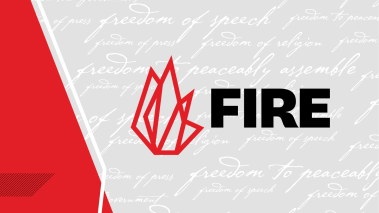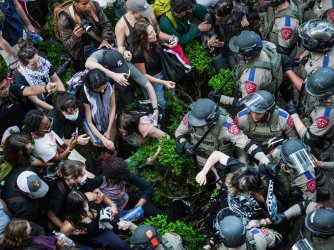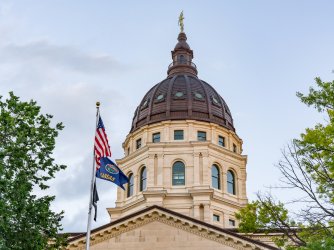Table of Contents
Sixth Circuit Relies on High School Cases to Assess Graduate Student’s Rights

Last week here on The Torch, I discussed the interesting ruling from the United States Court of Appeals for the Sixth Circuit in Ward v. Polite (.PDF). Before discussing the facts of the case and the Sixth Circuit's holding, I noted that while the court reached the right result by allowing the First Amendment lawsuit brought by expelled graduate student Julea Ward to continue, it did so in a way that may harm college student rights in the future.
Here's why: In analyzing Ward's claim that her First Amendment right to freedom of expression had been violated by Eastern Michigan University's decision to expel her, the Sixth Circuit relied on case law regarding student rights in public high schools.
This is problematic because courts have long recognized a distinct difference in the First Amendment rights available to K-12 students and college students, granting far more limited rights to high school students while affording public college students full First Amendment protection. The reasons for the discrepancy revolve around several factors: the differences in pedagogical mission between high schools and college; the fact that high schools are presumed to act in loco parentis (in place of the parent); and the average age of the students. And as former FIRE Justice Robert H. Jackson Legal Fellow Kelly Sarabyn has argued in her legal scholarship, the Twenty-Sixth Amendment, granting eighteen-year-olds the right to vote, was commonly understood at the time of passage "to entail the confirmation of full citizenship in the political order"—and, accordingly, to draw a bright line between the limited speech rights of high school students and the full speech rights of college students.
Other appellate courts have explicitly recognized this distinction. In striking down the University of the Virgin Islands' speech codes on First Amendment grounds in McCauley v. University of the Virgin Islands, the United States Court of Appeals for the Third Circuit in 2010 rejected the university's reliance on high school cases in its briefing, spelling out these differences at length and echoing arguments FIRE made in the amicus curiae brief we submitted to the court. Articulating the differing purposes of K-12 and higher education, the Third Circuit found that while grade and high schools "prioritize the inculcation of societal values. . . . [p]ublic universities encourage teachers and students to launch new inquiries into our understanding of the world."
Unfortunately, the Sixth Circuit's opinion in Ward rides roughshod over these considerations, treating legal precedent involving the rights of high school students and college students as though they were effectively interchangeable and of equal applicability in evaluating the merit of Ward's First Amendment claim.
Specifically, the Sixth Circuit relies heavily on the Supreme Court's holding in Hazelwood School District v. Kuhlmeier, 484 U.S. 260 (1988). In Hazelwood, high school student journalists for Hazelwood East High School's paper, The Spectrum, brought a First Amendment suit after two pages containing two separate articles — one about student pregnancy, and one about "the impact of divorce on students at the school" — were deleted by the school principal from an issue prior to publication. The paper was written for a journalism class—a crucial fact, because in holding that the school's censorship of the articles did not violate the First Amendment, the Court found that "educators do not offend the First Amendment by exercising editorial control over the style and content of student speech in school-sponsored expressive activities so long as their actions are reasonably related to legitimate pedagogical concerns."
As long-time FIRE supporters likely know, despite its high school origin, Hazelwood's broad grant of discretion to administrators seeking to silence student speech in "school-sponsored expressive activities" regrettably migrated to the collegiate setting, resulting in cases like Hosty v. Carter, 412 F.3d 731 (7th Cir. 2005) (en banc). In Hosty, an administrator at Governors State University in Illinois censored a student newspaper that had harshly criticized the university. In finding that the university's exercise of prior restraint over the student paper didn't violate the First Amendment, the United States Court of Appeals for the Seventh Circuit closely followed the analytical framework established by Hazelwood, blurring the clear distinction between the rights of high school students producing a paper for a journalism class and college journalists producing an independent college newspaper.
(Check out FIRE's Policy Statement on Hosty v. Carter for our full analysis of the opinion's missteps. Interestingly enough, in the wake of the Supreme Court's denial of certiorari for the case, several states, including Illinois, passed "anti-Hosty" legislation to preempt the ruling and protect student journalism.)
In considering Ward's First Amendment claim, the Sixth Circuit in Ward leans on Hazelwood to support its contention that "governmental bodies, including public high schools and universities, have considerable authority to control their own speech." Specifically, the court finds that schools can control their own curriculum—and thus a student's First Amendment rights, even if not checked at the schoolhouse gate (per the Supreme Court's famous decision in Tinker v. Des Moines Independent Community School Dist., 393 U.S. 503, 506), are far reduced in the classroom setting as a function of pedagogical control. The court writes:
All educators must be able "to assure that participants learn whatever lessons the activity is designed to teach." Hazelwood, 484 U.S. at 271. Just as a junior high school English teacher may fail a student who opts to express her thoughts about a once-endangered species, say a platypus, in an essay about A Tale of Two Cities, see Settle, 53 F.3d at 155, so a law professor may fail a student who opts to express her views about Salvador Dali and the fourth dimension in a torts exam. That the First Amendment protects speech in the public square does not mean it gives students the right to express themselves however, whenever and about whatever they wish on school assignments or exams. "A school need not tolerate student speech that is inconsistent with its basic educational mission." Hazelwood, 484 U.S. at 266.
This point, which the court makes at considerable length, is of course fair enough: schools have the right, as a matter of both basic pedagogy and institutional academic freedom, to set the parameters of academic study, and teachers may determine how best to teach. (This is why FIRE generally doesn't get involved in cases involving simple grading disputes.) Indeed, the Sixth Circuit might have saved itself some time and simply relied on Justice Felix Frankfurter's concurring opinion in Sweezy v. New Hampshire, 354 U.S. 234, 263 (1957), in which he highlighted "‘the four essential freedoms' of a university-to determine for itself on academic grounds who may teach, what may be taught, how it shall be taught, and who may be admitted to study." [Internal citation omitted].
Instead, the Sixth Circuit, like the Seventh Circuit in Hosty, imports Hazelwood's core holding—"public educators may limit ‘student speech in school-sponsored expressive activities so long as their actions are reasonably related to legitimate pedagogical concerns'"—from the high school arena into higher education. The court explicitly acknowledges this importation, again at length:
The Hazelwood test, it is true, arose in the context of speech by high school students, not speech by college or graduate students. But for the same reason this test works for students who have not yet entered high school, Curry ex rel. Curry v. Hensiner, 513 F.3d 570, 576-78 (6th Cir. 2008) (elementary school); Settle v. Dickson Cnty. Sch. Bd., 53 F.3d 152, 155 (6th Cir. 1995) (junior high school), it works for students who have graduated from high school. The key word is student. Hazelwood respects the latitude educational institutions-at any level-must have to further legitimate curricular objectives.
[ . . . ]
Nothing in Hazelwood suggests a stop-go distinction between student speech at the high school and university levels, and we decline to create one. Hosty v. Carter, 412 F.3d 731, 734 (7th Cir. 2005) (en banc) (applying Hazelwood in university setting); see also Keeton v. Anderson-Wiley, No. 10-13925, ___ F.3d ___, 2011 WL 6275932, at *7-8 (11th Cir. December 16, 2011) (same); Axson-Flynn, 356 F.3d at 1289 (same); Brown v. Li, 308 F.3d 939, 949 (9th Cir. 2002) (same). To our knowledge, just one circuit has gone the other way-and that in a footnote, Student Gov't Ass'n v. Bd. of Trustees of Univ. of Mass., 868 F.2d 473, 480 n.6 (1st Cir. 1989), and even then based on what seems to be a misconception that Hazelwood decided the issue (it did not), see Hazelwood, 484 U.S. at 273 n.7.
The Sixth Circuit justifies bringing Hazelwood's holding into the higher education context by noting that Hazelwood can be read as requiring would-be college censors to consider the "maturity" of the students they're silencing:
By requiring restrictions on student speech to be "reasonably related to legitimate pedagogical concerns," Hazelwood allows teachers and administrators to account for the "level of maturity" of the student. 484 U.S. at 271. Although it may be reasonable for a principal to delete a story about teenage pregnancy from a high school newspaper, id. at 274-75, the same could not (likely) be said about a college newspaper. "To the extent that the justification for editorial control depends on the audience's maturity, the difference between high school and university students" makes all the difference. Hosty, 412 F.3d at 734.
But, as that cite to Hosty makes all too clear, assuming that administrators will check their impulse to censor by considering the maturity of the students they're seeking to silence just isn't much comfort for organizations and advocates like FIRE that work to protect college student rights. Frankly, our case archive is just too large. So even though Hazelwood is being deployed by the Sixth Circuit here in support of a relatively straightforward, uncontroversial point — "When a university lays out a program's curriculum or a class's requirements for all to see, it is the rare day when a student can exercise a First Amendment veto over them" — the mere suggestion that universities may, in the absence of an explicit "stop-go distinction," rely on high school speech restrictions to justify collegiate censorship should be of real worry.
Again, Hosty is a prime example. It's worth remembering, too, that there's no stated "stop-go distinction" in, say, Morse v. Frederick, 127 S.Ct. 2618 (2007) (holding that the suspension of a high school student for a banner reading "BONG HiTS 4 JESUS" did not violate the First Amendment because "schools may take steps to safeguard those entrusted to their care from speech that can reasonably be regarded as encouraging illegal drug use"), so what's to stop the wholesale importation of other restrictions on high school student speech into the college context?
And of course, courts citing the Sixth Circuit's lengthy discussion of Hazelwood's applicability to college speech may not be doing so for such relatively benign ends. While the Sixth Circuit's use of Hazelwood here is essentially cabined to the question of curricular control, by supplying future courts with pages of dicta discussing why Hazelwood is good law on college campuses, the court has nevertheless provided would-be campus censors with plenty of room for mischief.
In need of First Amendment resources for teachers? The Foundation for Individual Rights and Expression has you covered. Our "First Things First" First Amendment textbook for college undergraduates explores the fundamentals of modern American free speech law. Meanwhile, our K-12 First Amendment curriculum modules help educators enrich and supplement their existing instruction on First Amendment and freedom of expression issues in middle and high school classrooms. Explore thefire.org for even more First Amendment educational resources.
Recent Articles
FIRE’s award-winning Newsdesk covers the free speech news you need to stay informed.

Should the First Amendment protect hate speech?
In America, hate speech is generally protected by the First Amendment. But should it be? Today's guest is out with a new book, "." W. Wat Hopkins is emeritus professor of communication at Virginia Tech, where he taught communication law and...

Here’s what students need to know about protesting on campus right now

Kansas takes a stand for intellectual freedom
